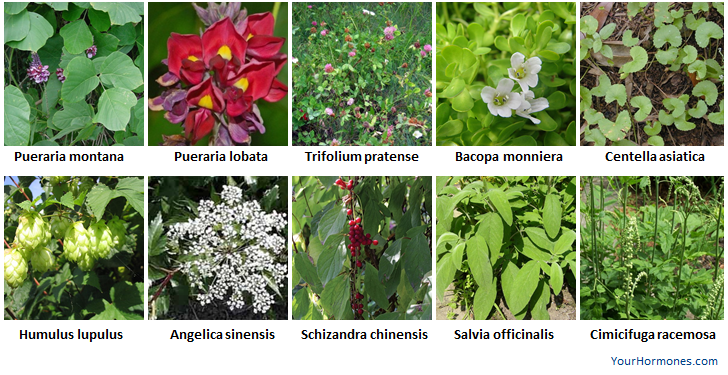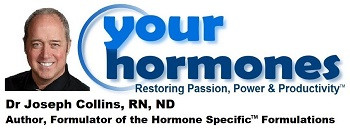
Anticancer Herbs and Bioidentical Hormone Replacement Therapy by Joseph J Collins, RN, ND
By going through series of articles on Anticancer Actions of Specific Herbs for Low Estrogen Symptoms, we have reviewed the science that shows anticancer actions in Pueraria montana & Pueraria lobata, Trifolium pratense, Bacopa monnieri, Centella asiatica, Humulus lupulus, Angelica sinensis, Schizandra chinensis, Salvia officinalis & Cimicifuga racemosa. As noted in the beginning, these herbs collectively have antiproliferative, anticancer and anti-carcinogenic actions as well as other properties that provide anticancer protection.
Use with Bioidentical Hormone Replacement Therapy
Since these herbs do not increase estrogen production, and since each herbs have documented anti-cancer properties, it is reasonable to consider using these herbs with each of those herbs with Bioidentical Hormone Replacement Therapy (BHRT. In fact, that was one of the reasons that I developed a specific formulation to manage symptoms of low estrogen. I saw many women on good, appropriate and healthy dosages of BHRT, but they still dad symptoms of low estrogen.
Understanding BHRT
It is important to understand that natural estrogens are proliferative hormones and a woman’s exposure to estrogens over her lifetime can increase her risk of breast cancer, regardless of whether or not the estrogens are produced by her own body or taken in a bioidentical form.
In fact, when a compounding pharmacist dispenses compounded bioidentical hormone replacement therapy (BHRT) with estrogens, they will typically provide a Patient Information document that will mention that fact that estrogens (even BHRT) may increase the chance of getting certain types of cancer, including cancer of the breast. The Patient Information document typically will go on to say that if you have cancer, or have had cancer you should talk to your healthcare provider about whether you should take estrogens (even bioidentical estrogens).
Keep in mind that I am a very strong proponent of BHRT. Pure estradiol is safer, and not as potent (not as proliferative) as estrogens concentrated from horse urine (Conjugated Estrogens), or synthetic estrogens (such as Ethinyl Estradiol). On page 328 of Discover Your Menopause Type I point out that Conjugated Estrogens are 2.17 times as potent as estradiol, and that Ethinyl Estradiol is actually 419 times as potent as estradiol. To be fair, Ethinyl Estradiol is usually given in lower dosages, but that is still an awfully strong synthetic estrogen!
The Multiple Actions of Herbs
While herbs may become famous for a specific action that they have, the truth is that all herbs have multiple actions. Of interest, the herbs that have been discussed in this series of article have been described as having “phytoestrogen” properties, and they can relieve many of the symptoms associated with low estrogens levels. However, each of the herbs that are mentioned have been documented to have anticancer properties. In fact, some of the herbs have very significant anticancer properties. For example, Trifolium pratense (Red Clover) has traditionally been used in herbal anticancer formulations such as the Hoxsey formula, and the Essiac formula.
But keep in mind that as well as having anticancer actions, these herbs can be very effective in relieving hot flashes, night sweats, insomnia, fatigue, weight gain, memory changes and other common problems that occur with low estrogen. So, women can actually have relief from estrogen deficiency symptoms using the proper combination of these herbs that have anticancer actions.
Choosing the Correct Herbs
When I first started using these herbs I was working on a formulation that would relieve estrogen deficiency symptoms, but would be safe enough so that women with a history of cancer could use it. So I did not include herbs that have been shown to raise blood levels of estradiol, such as Paeonia lactiflora and Trigonella foenum-graecum. However, I may use Paeonia lactiflora and Trigonella foenum-graecum for women who have excessive testosterone and low estradiol if they have no history of cancer. Different herbs have different properties and are useful for specific needs.
The most important thing to remember about the specific herbs to treat low estrogen symptoms with anticancer actions that were discussed in this series of articles, is that they do not raise estradiol levels, but can still relieve estrogen deficiency symptoms.
If someone wants to actually lower the amount of estrogens that their body makes, then I would suggest other herbs that decreases estrogen production by blocking the enzyme in our bodies that make estrogens. The enzyme that converts androgens (such as testosterone) into estrogens is called “aromatase”. Herbs and plant extracts that inhibit aromatase activity are called aromatase inhibitors.
How These Herbs Are Used
Since Pueraria montana& Pueraria lobata, Trifolium pratense, Bacopa monnieri, Centella asiatica, Humulus lupulus, Angelica sinensis, Schizandra chinensis, Salvia officinalis & Cimicifuga racemose do not increase estrogen production, each of those herbs could also be used with the herbs and plant extracts I use to inhibit aromatase activity.
These herbs can be used in many different cases, including:
- People who do not want to use Estrogen Replacement Therapy (ERT) - because of personal or family history of estrogen sensitive cancer. Use these herbs to decrease or eliminate symptoms without ERT.
- People who are on ERT who still have symptoms - even when lab tests confirm optimal estradiol levels.
- People on ERT who want to decrease side effects & risks associated with ERT - such as breast discomfort, other symptoms of estrogen sensitivity or concerns about increased risk of estrogen sensitive cancers.
- People who want to wean off of ERT should start these herbs a month before weaning off of ERT to successfully wean off of ERT without symptoms of estrogen withdrawal.
Hormone Health
While it is very encouraging to see that specific herbs used to treat low estrogen symptoms also have anticancer actions, it is also important to maintain a healthy lifestyle that includes whole foods, as well as moderate exercise and proper recreation, water consumption, and sleep. To learn more about the basics of hormone health, please study the Hormone Health educational module.
